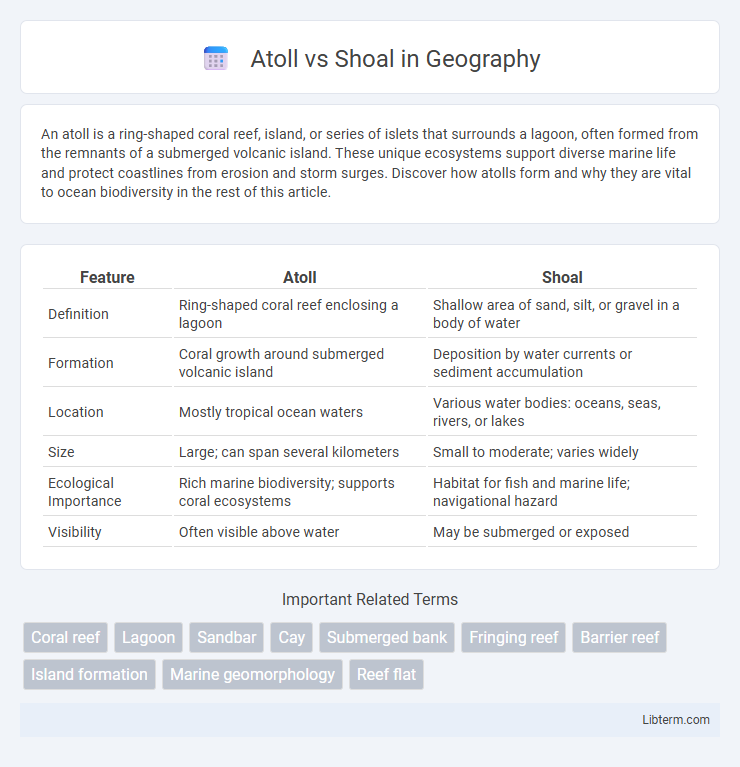An atoll is a ring-shaped coral reef, island, or series of islets that surrounds a lagoon, often formed from the remnants of a submerged volcanic island. These unique ecosystems support diverse marine life and protect coastlines from erosion and storm surges. Discover how atolls form and why they are vital to ocean biodiversity in the rest of this article.
Table of Comparison
| Feature | Atoll | Shoal |
|---|---|---|
| Definition | Ring-shaped coral reef enclosing a lagoon | Shallow area of sand, silt, or gravel in a body of water |
| Formation | Coral growth around submerged volcanic island | Deposition by water currents or sediment accumulation |
| Location | Mostly tropical ocean waters | Various water bodies: oceans, seas, rivers, or lakes |
| Size | Large; can span several kilometers | Small to moderate; varies widely |
| Ecological Importance | Rich marine biodiversity; supports coral ecosystems | Habitat for fish and marine life; navigational hazard |
| Visibility | Often visible above water | May be submerged or exposed |
Definition of Atoll
An atoll is a ring-shaped coral reef, island, or series of islets that encircle a lagoon partially or completely, formed from the sinking of volcanic islands and subsequent coral growth. Shoals refer to shallow areas in bodies of water caused by accumulation of sand, silt, or other sediments, often posing navigation hazards. While atolls are distinctive coral formations with ecological and geological significance, shoals represent underwater elevations primarily affecting marine and shipping conditions.
Definition of Shoal
A shoal is a natural underwater ridge, bank, or bar composed of sand, gravel, or other sediments that rises close to the water's surface, often posing navigational hazards. Unlike an atoll, which is a ring-shaped coral island surrounding a lagoon formed from coral reef growth and volcanic activity, a shoal lacks a lagoon and coral reef structure. Shoals are commonly found in coastal waters and riverbeds, influencing marine ecosystems and sediment transport.
Formation Processes: Atoll vs Shoal
An atoll forms from the gradual subsidence of a volcanic island surrounded by coral reefs that grow upward, creating a ring-shaped coral structure enclosing a lagoon. In contrast, a shoal is a shallow area formed by the accumulation of sand, silt, or other sediments deposited by currents or tides, often near shorelines or river mouths. While atolls result from biological coral growth and volcanic activity, shoals are primarily sedimentary features influenced by hydrodynamic processes.
Key Physical Characteristics
An atoll is a ring-shaped coral reef, island, or series of islets surrounding a central lagoon, formed from the subsidence of a volcanic island. Shoals are shallow areas in bodies of water, composed primarily of sand, gravel, or small rocks, and often pose navigational hazards due to their low depth. Atolls typically exhibit significant coral reef development and enclose deeper lagoons, whereas shoals are characterized by their shallow depth and sediment accumulation without forming enclosed water bodies.
Ecological Importance
Atolls provide critical habitats that support diverse marine ecosystems, including coral reefs, fish species, and seabirds, contributing significantly to global biodiversity. Shoals, composed mainly of sand or gravel, create shallow water environments that serve as crucial breeding and feeding grounds for numerous aquatic species and help protect coastlines from erosion. Both atolls and shoals play essential roles in maintaining ecological balance and supporting fisheries that sustain local communities.
Geographic Distribution
Atolls predominantly occur in tropical oceanic regions, especially in the Pacific and Indian Oceans where volcanic islands have subsided and coral growth has continued. Shoals are more widely distributed globally, found in coastal and inland waters, often formed by sand, silt, or gravel deposits creating shallow areas. Geographic distribution of atolls is closely linked to tectonic activity and warm water conditions optimal for coral reefs, whereas shoals depend largely on sediment dynamics and hydrodynamic processes.
Human Interaction and Usage
Atolls, ring-shaped coral reefs surrounding lagoons, often support human settlements and tourism due to their rich marine biodiversity and calm waters ideal for fishing and water sports. Shoals, shallow areas made of sand or rocks, can pose navigational hazards but also create productive fishing grounds and attractive spots for shellfish harvesting and recreational activities. Both natural formations influence coastal communities by providing resources, impacting maritime routes, and shaping local economies.
Threats and Conservation Challenges
Atolls face significant threats from sea level rise and coral bleaching due to climate change, which endangers their delicate ecosystems and freshwater supplies. Shoals are vulnerable to habitat disruption from coastal development, sedimentation, and pollution, which degrade their biodiversity and fish populations. Conservation challenges for both include limited funding, insufficient enforcement of marine protected areas, and the need for integrated management to balance human activities and ecological preservation.
Navigational Implications
Atolls present significant navigational challenges due to their ring-shaped coral reefs encircling lagoons, often featuring shallow waters and submerged reef structures that can pose risks to vessels. Shoals, characterized by shallow sandbanks or ledges just below the water surface, demand careful charting and depth awareness to avoid groundings, especially in tidal zones with fluctuating water levels. Accurate hydrographic surveys and updated nautical charts are essential for safely navigating both atolls and shoals, as their dynamic environments can rapidly change due to natural factors like sediment deposition and coral growth.
Summary Comparison: Atoll vs Shoal
An atoll is a ring-shaped coral reef, island, or series of islets surrounding a lagoon, typically formed from the growth of coral on a submerged volcanic island. A shoal refers to a natural submerged ridge, bank, or bar of sand, gravel, or other sediment that is shallower than the surrounding water, often posing navigational hazards. Atolls are primarily biological structures formed by coral ecosystems, while shoals are primarily geological formations caused by sediment accumulation.
Atoll Infographic

 libterm.com
libterm.com